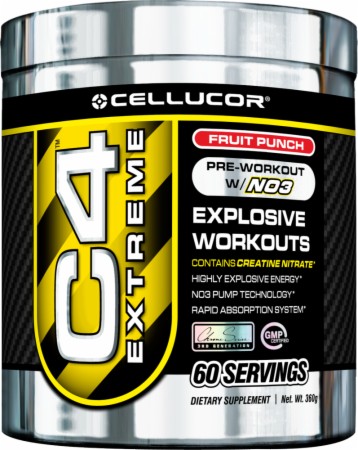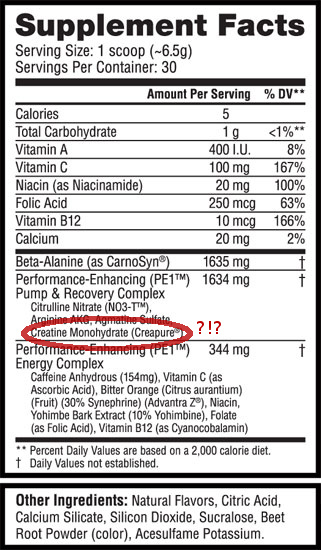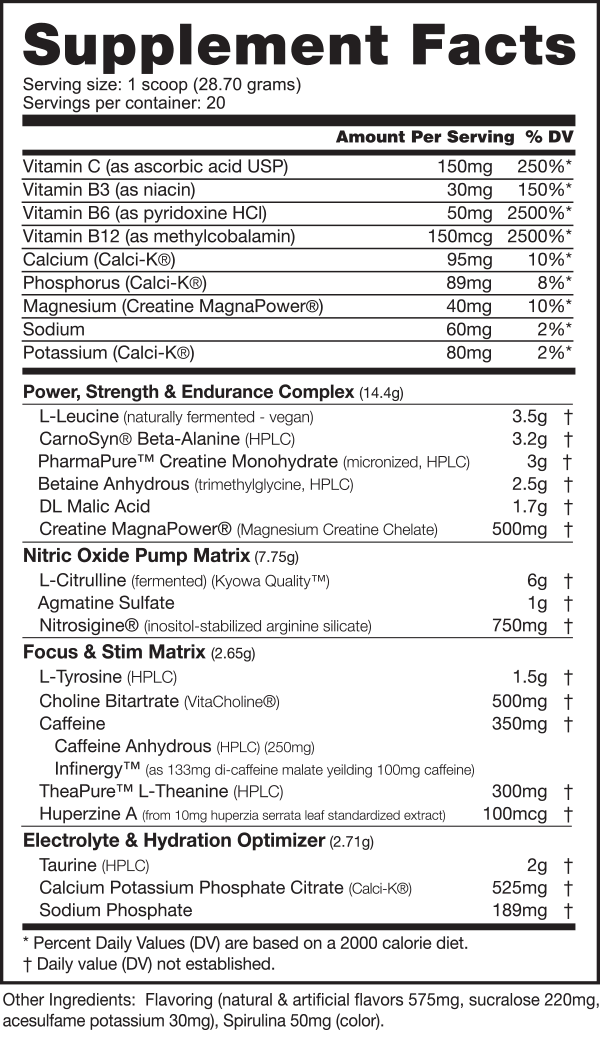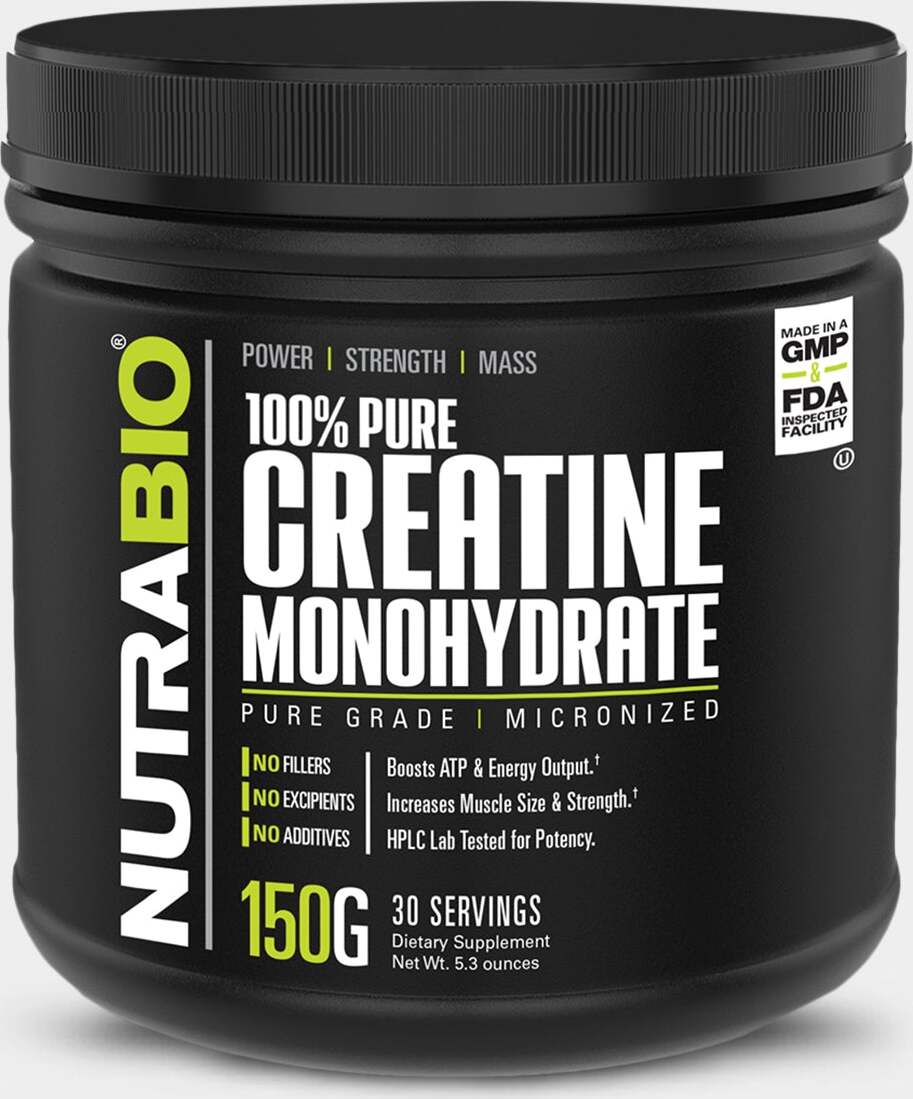At this stage in the game, we don't need to tell you that creatine is an incredible supplement. It's one of the most well-researched compounds on the market, it's safe, it's simple, and it's cheap.
But right now, the state of creatine is a mess... and the big brand pre workouts are to blame.
TL;DR
- Creatine is great. There's no easier way to make some gains than taking 3-5g daily.
- But it's consistently underdosed in most top-selling pre workout supplements.
- This has led to too many confused consumers, many of whom are ultimately not getting enough of this most staple supplement.
- Our message to consumers: bulk creatine is crazy cheap. Make sure you're getting enough each and every day.
- Our message to supplement brands: do it right or don't do it at all.
This is a rant meant to educate and inspire.
The products that are discussed on this page are ones that we actually use and truly love. So consider this a letter of tough love.
Why creatine is great
In case you aren't up to speed, below are the reasons why it's so incredible why it's so incredible.
(Click here to skip this section if you already know about creatine and want to cut to the chase.)
-
It's one of the most well researched compounds on the market.
There are hundreds of studies[1] documenting its beneficial use in almost any fitness context imaginable, delving into every single facet of how it works at the molecular level, and exploring how it interacts with body systems - even those completely unrelated to sports performance. Very few (if any) other supplements on the market can claim anywhere near the volume of academic attention that creatine has received.
-
It's safe
Furthermore, creatine has a robust safety profile. Neither acute[2] or chronic[3] studies demonstrate a side effect profile that is statistically significantly different from placebo. There is the occasional case of GI distress, but even those examples are few and far between.
-
It does NOT cause kidney issues
In fact, one study even had a subject with only one kidney... and he had no issues![4]
And despite the unfounded wave of criticism of creatine, it does not pose a risk to kidney health in healthy individuals.
The real story is that creatine is metabolized into creatinine, elevated levels of which are often used as a biomarker for kidney health. What this means is that while creatine won't cause kidney problems, it can lead to a false positive due to increasing creatinine levels.
However, on multiple occasions has still been shown to be safe under long-term consumption, so long as you have healthy kidneys with no pre-existing conditions![3,5,6]. The studies cited here studied creatine usage from ten months to over five years!
In fact, one study even had a subject with only one kidney, and they loaded him with 20g of creatine per day for 5 days followed by 5g per day for the next 30 days, and he had no issues![4]
Needless to say, the numerous studies performed on both humans and rats, sick and healthy, have long since put the creatine kidney question to bed. All that remain are old wives tales.
-
-
...and it's cheap
Creatine is also cheap, incredibly cheap. Our top supplement deals page regularly features bulk creatine powder products as cheap as $.01/gram, and is almost always available for $0.015/gram. At less than 7 cents per day, this makes creatine the single greatest bang for your buck supplement in the entire industry.
Hell, the majority of the cost of a tub of creatine isn't even the creatine itself! Putting creatine in a shipping container, sending it to a manufacturer, bottling it, and slapping a label on it is the majority of the cost of a straight pure creatine product.
This is actually part of the problem we're about to dig into - more on that later.
So what's the real problem we have here?
Creatine works - but the dose in your preworkout probably doesn't
But you didn't come here to hear about why creatine is awesome, you already knew that.You're here because we told you that your creatine supplement is broken, so lets get on to the main event.
The broken thing about your creatine supplement is that it's far too often underdosed.
We mentioned the enormity of scientific work on creatine earlier, and want to point out something almost all of those studies have in common, so here's some excerpts from just a few studies:
Notice a trend in these successful studies:
- "For 6 days the creatine group (n=12) ingested 5g creatine monohydrate"[7]
- "Nineteen swimmers in the experimental group received creatine monohydrate 5g with orange solution 15g, twice per day for 7 days"[8]
- "Subjects were randomly assigned to one of the following groups: PRE-SUPP or POST-SUPP workout supplementation of creatine (5 grams)."[9]
- "Creatine monohydrate (10g daily for 5 days to 5g daily for 5 days)"[10]
- "The Cre group ingested 15g/day of CrM for 7 days and 3g/day for the remaining 49 days"[11]
What do all of these studies have in common? Significant dosing!
We're talking 5g/day for the non-loading studies, or even 3g/day after being loaded with a whopping 15 grams a day to start.
Additionally, lets see what the most esteemed academic group on the subject of sports nutrition, ISSN, has to say about creatine dosing in their official position stand on creatine supplementation:
"The quickest method of increasing muscle creatine stores appears to be to consume ~0.3 grams/kg/day of creatine monohydrate for at least 3 days followed by 3–5 g/d thereafter to maintain elevated stores. Ingesting smaller amounts of creatine monohydrate (e.g., 2–3 g/d) will increase muscle creatine stores over a 3–4 week period, however, the performance effects of this method of supplementation are less supported."[12]
--ISSN, International Society Of Sports Nutrition
Again, the academic consensus appears to be that you need 3 to 5 grams per day.
And then there's the loading debate...
Not because the molecule is broken (it very much isn't), but because the creatine market has been broken by underdosed pre workouts and lack of consumer education
Additionally, they advocate for the loading period. Now, the loading period has been subject of some level of controversy over the years, with many people pointing out how it's unnecessary and provides no appreciable benefit other than convincing you to buy more creatine.
...but creatine is so cheap the debate is no longer important
Since creatine's as cheap as it is now, loading your creatine is worth considering if you're just starting out and want to replicate the success of the aforementioned studies.
Taking 10-20g/day for a the first week you start is only going to cost you a couple bucks. It should saturate your creatine stores quicker and help you start seeing improved gains sooner.
So what's in your popular pre workout?
Now that we've got that settled, lets take a look at the creatine content of some of the top selling preworkout products on the market today. Again, this isn't meant to be some huge call out or insult to these companies, these products sell extremely well for a reason and are generally made by good people:
Note: The following list is now out of date, but the products discussed below are still great examples
-
Cellucor C4 Extreme and the New Cellucor C4 Formula
We love it, but this top seller has possibly led to more creatine confusion than any other product. Relevant forum threads are cited below.
1g Creatine Nitrate (which is about 675mg of creatine) per serving.[13] There's a two serving max recommended dose, so 1.35 grams of creatine per max recommended serving.
Interestingly, the C4 Sport's Strength version has a legit dose of creatine, so it could be reasonably argued that Cellucor's Wal-Mart customers are actually going to end up with better gains than their core customers at supplement retailers worldwide!
-
MusclePharm Assault
1g Creatine Nitrate per serving. Most people aren't taking more than 1 scoop of this, that leaves just 675mg of creatine per workout.
-
ProSupps Mr Hyde
1 gram of creatine per scoop, and it has a staggering 419mg of caffeine per scoop in it, so taking more than one scoop isn't really much of a good idea.
-
EVL Nutrition ENGN
1.25g per scoop, 2 scoop max dose, 2.5 grams of creatine per max serving. Close... if you can handle that level of stimulants!
-
Labrada PE-1
Seriously?
Another fully blended product, this time 6.5 grams per scoop, with creatine last in a sub-blend of four ingredients that contains 1,634mg of ingredients.
This means that due to label laws, the absolute maximum amount of creatine that could be in a serving of PE-1 is a mere 408mg of creatine - but it's likely less than that!
When you compare these doses to those used in clinical trials, most of these products aren't even close, and these represent some of the best-selling pre workouts on the market!
To make matters worse, there's the matter of off-days, where a pre workout is typically not taken.
So why the heck do companies even bother including ineffective doses of creatine in their products when it is incredibly cheap, and incredibly useful?
Down the rabbit hole we go...
What's the big deal? Just add more!
Many consumers have read informative articles about creatine in magazines, blogs, or posts on forums, and have some level of quality knowledge on how much creatine you need.
Those consumers aren't who we're worried about -- if you're on this page, chances are you're one of them. Most of you see the amount of creatine in a products and just dump a spoonful of extra bulk creatine into your preworkout drink and you're done with it.
It's not the well-read consumers who are missing out
The fuss is for all of the naive brick and mortar store consumers, teenagers, and novices who are new to supplements and exercise.
This group of people thinks "oh hey, it's on the label, it must be a good ingredient and I'm set for the day". They might see an ad for creatine and think "oh, I saw that on my preworkout label, I guess I've already got my creatine covered."
And therein lies the problem. The users who could use it the most are less likely to buy separate creatine - it's already in their mass-market preworkout (quite easily one of those listed above) - and they don't know any better, nor is anyone educating them!
They're essentially giving up cheap and easy gains because they've been lulled into a false sense of security.
Confused customers for no good reason
Don't believe it? Go look at any supplement discussion forum and you'll see just how right we are.[14-18]
Google suggests a similar situation:
Underdosing creatine or putting it into a proprietary blend simply creates confusion amongst users.
Above, even some of those asking above are intermediate-level lifters, trying to figure out what's going on. Consider how many people didn't care to get on a forum, or didn't even realize they weren't getting a good dose!
The last thing the supplement industry should be doing is confusing the hell out of their new and hopefully eventually repeat customers - especially when it's the most effective and one of the cheapest ingredients on the market!
So why is this happening?
As we've said a couple of times, bulk creatine is cheap, so it's not like you're being shortchanged on it because your supplement manufacturer wants to save 10 cents per tub on creatine. But we've got a explanations of what's at play here:
-
Cheap concentrates and real estate
Creatine might be cheap, but most preworkouts these days are 'concentrated' small scoop products, and in a 5 gram scoop, putting 3g of creatine in is just too much real estate to invest.
This is an entirely valid point, but it begs the question of why include creatine at all if you're not going to include an effective dose?
-
Marketing recognition
Because everyone recognizes creatine, and products with it seem to sell better than products without.
Teenagers, casual exercisers, and people that are generally naive about supplements see creatine on the label and think 'oh yeah, I've heard about creatine, awesome, this product includes it'.
It's not about putting in effective doses of creatine, it's about just getting it on the label for recognition purposes. Look no further than the Labrada PE-1 product above to see this in action.
-
Upselling opportunities (creatine products)
Companies want to sell you an another 'creatine' product in addition to your preworkout. The economics of the supplement market are changing. People want to buy cheaper preworkout products so in todays market, concentrates are king.
If you look at the random sampling of products we listed before, you'll conveniently find an add on creatine SKU in most of their product lines (Cellucor Cor-Performance Creatine, MusclePharm Creatine). Companies know if they can convince people to buy one product (their preworkout), then it makes those people far more likely to buy their other products (their creatine).
Unfortunately, the sales volume of something like Cor-Performance Creatine aren't even in the same ballpark as the volume of C4, so this add-on approach clearly isn't reaching most consumers.
If they made it clear on their products that you should be taking additional creatine, this wouldn't really be a problem. But most of them don't, leaving uninformed buyers in the dark about the fact that they aren't taking enough creatine!
So how many people out there are only getting 1-1.5g creatine per workout day, if that?
Unfortunately, this is far too often the case. Why should we need three products to get a reasonable dose anymore?
-
More upselling (platform sales)
And finally, there's some companies that break up their creatine dose between numerous peri-workout products. With a gram or two each in their pre, intra, and post workout products.
If you ask them about how much creatine is in their preworkout, they'll just refer you to their other products in hopes you buy more.
We're really not a big fan of this practice, companies shouldn't be trying to force brand loyalty by making you buy 2-3 full formula products just to get a full dose of seven cents worth of creatine.
And at this point, you can see that creatine is broken.
Not because the molecule is broken (it very much isn't), but because the creatine market has been broken by underdosed pre workouts, lack of consumer education, and a new unwillingness to buy separate creatine products, as cheap as they are.
It's not the end of the world, but it sure is a lame way to limit a beginner's gains. And those beginner gains are what got most of us hooked here in the first place!
So who's doing it right?
Alright, we've done our fair share of complaining about people doing it wrong, time to give you some product recommendations for top ranked preworkouts that aren't afraid to sell you a product loaded with fully dosed creatine.
-
NutraBio Pre Workout
Behold the NutraBio PRE Workout Ingredients - v5! You may even be able to get two solid workouts out of this packet!
NutraBio PRE Workout – Deals and Price Drop Alerts
Get Price Alerts
No spam, no scams.
Disclosure: PricePlow relies on pricing from stores with which we have a business relationship. We work hard to keep pricing current, but you may find a better offer.
Posts are sponsored in part by the retailers and/or brands listed on this page.
Label above. Enough said!
-
Optimum Nutrition Gold Standard Pre Workout
A very recent foray into the preworkout game by ON, this product has 3 grams per scoop, with a max serving of 2 scoops. That means you're getting 3-6 grams of creatine per workout, right in line with what you want.
Optimum Nutrition Gold Standard Pre Workout – Deals and Price Drop Alerts
Get Price Alerts
No spam, no scams.
Disclosure: PricePlow relies on pricing from stores with which we have a business relationship. We work hard to keep pricing current, but you may find a better offer.
Posts are sponsored in part by the retailers and/or brands listed on this page.
Want to keep your underdosed concentrate? Just add bulk creatine
If you like the preworkout you're already taking, but it's either underdosed with creatine, or omits it entirely, you're in luck. Quite a few companies sell large containers of standalone creatine at very affordable prices.
Here's a few examples from reliable companies:
-
NutraBio Creatine Monohydrate
The only one you'll find in sports nutrition (as of time of updating this post in 2019) that actually publishes third-party lab tests!
NutraBio Creatine Monohydrate – Deals and Price Drop Alerts
Get Price Alerts
No spam, no scams.
Disclosure: PricePlow relies on pricing from stores with which we have a business relationship. We work hard to keep pricing current, but you may find a better offer.
Posts are sponsored in part by the retailers and/or brands listed on this page.
-
Optimum Nutrition Micronized Creatine
ON is the most trusted source of basic goods. They're a bit more expensive than others, but most consumers are happy with that.
Optimum Nutrition is one of the biggest companies in the industry, and while their standalone creatine isn't as cheap as some of the others, they are virtually never out of stock, 100% trusted, and available on pretty much every supplement website.
Optimum Nutrition Micronized Creatine Monohydrate – Deals and Price Drop Alerts
Get Price Alerts
No spam, no scams.
Disclosure: PricePlow relies on pricing from stores with which we have a business relationship. We work hard to keep pricing current, but you may find a better offer.
Posts are sponsored in part by the retailers and/or brands listed on this page.
If you wait to buy one of the above products on sale in a 1000g container, you can sign up for price drop alerts and find yourself close to a year's worth of creatine for nearly $10.
But even at regular prices, if you're buying a preworkout, protein, and/or other supplements every month anyway, you've got almost nothing to lose adding a creatine product to your supplement mix.
Do it right, or...
To sum up our feelings, it's gotten to the point where we feel that a company should either do it right (like the products listed above), or not do it at all.
Our Top 10 Pre Workout Supplements list has many well-dosed ones. There are dozens of others, so take a look at your situation, and ask yourself, "Am I getting at least 3g per day? What about off days?"
The industry's double-standard
One last note. We find it interesting that nearly no stimulant-free pre workout pump supplements contain any creatine. This is a growingly popular category, and these pump products are almost always geared towards the muscle-building market.
So why isn't creatine in the stim-free products that are universally marketed towards those who'd actually use the ingredient, while so many concentrates marketed for "everyone" do get underdosed creatine?
The answer to that question might be the rationale for this whole mess.
Our guess is this: On top of the upsells mentioned above, it comes from a form of laziness. Rather than educate the average consumer on why they should get efficacious amounts, some brands lazily figured, "Oh, these people aren't going to buy bulk creatine, so ~1g is better than nothing."
And while that may be "correct", but that doesn't make it right.
Long story short.
If nothing else, it might be time to go get a cheap tub. $15 worth will last you the majority of the year, and creatine is simply too good and too cheap to half-ass.











Comments and Discussion (Powered by the PricePlow Forum)